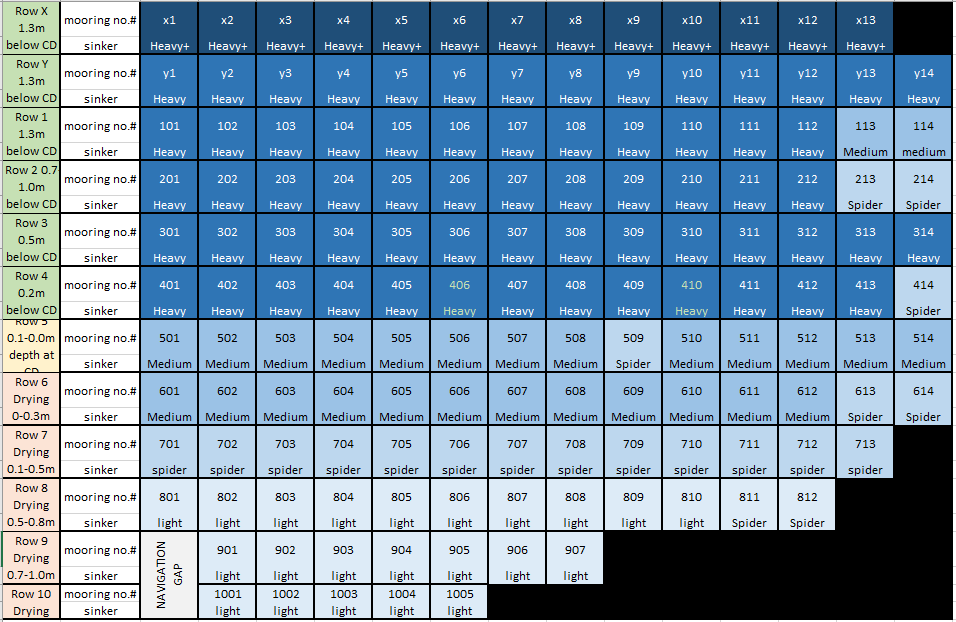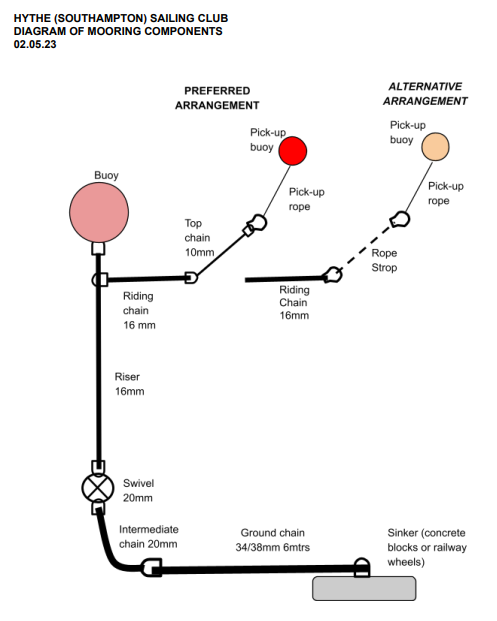Mooring and Pound
Cruiser pound at HSC
HSC currently has 148 Cruiser Pound spaces. These pound spaces are available to our members with cruiser yachts with a maximum draught of 1.6m and require members to have a safe and suitable trailer or cradle to store their boat on. Members that hold a pound space are required to have a mooring in accordance with the club byelaws. Cruisers stored in the pound are required to launch yearly to encourage an active sailing community. For further information please see our Mooring and Pound Byelaws.
The pound spaces are provided with electrical power and access to water supplies, which allow our members to work on their boats/trailers/cradles.
The cruiser Pound is set out into 6 rows with all boats being accessible. Each pound space has room to move around the boat allowing our members to work on and maintain their boats. Please see the cruiser pound diagram below:

HSC has 2 tractors for moving/launching/recovering boats. Each cruiser must be launched / recovered and stored on its own trailer, or in a purpose-made cradle that fits the club’s two trailers. The use of the club trailers is available to members at a small charge. As well as this, the club has outboard storage which again can be requested by our members.
Launching/ recovery from/to the pound requires our members to organise and arrange this with the club and our team of tractor drivers and it must be done at a suitable height of tide. The toe of the slipway is at 2.45m above chart datum. Launching/recovery of boats requires trailers/cradles to be inspected and deemed safe and fit for purpose. Our members with trailers/cradles are responsible for their maintenance and must make sure they are safe and fully functional.
The club Pound Master oversees the management of the cruiser pound and makes sure the pound is clean, safe and boats are secure in the correct spaces.
There are a number of tasks that are part of the “Work Party Scheme” and all boat owners are expected to help with this operation to ensure the smooth running of the club.
Dinghy Pound at HSC
HSC currently has 56 dinghy pound spaces. These spaces are available to our membership even those already with cruisers. We again encourage an active sailing community and require in accordance with our club byelaws that dinghies are active and launched at least once per year.
Our dinghy pound has access to winches to support launch and recovery of our members boats. The entrance to the dinghy pound had both electric and water to support our members to maintain their dinghies. Please see the dinghy pound diagram below:

The club Pound Master oversees the management of the dinghy pound and makes sure the pound is clean, safe and boats are secure in the correct spaces.
There are a number of tasks that are part of the “Work Party Scheme” and all boat owners are expected to help with this operation to ensure the smooth running of the club.
Moorings at HSC
HSC currently has 155 “swinging moorings” for cruisers on Southampton Water, opposite and downstream from the Club House. The “outer” two rows are suitable for yachts up to 12 metres in length. These outermost moorings are allocated to yachts up to 2 metres draft and generally they do not touch bottom except at a very low spring tide.
The other moorings are allocated to shorter boats, with maximum lengths related to the type of mooring sinker. The very innermost moorings dry at low tide; however, the seabed is very soft mud throughout the moorings. A tender is required to reach your boat and during the sailing season it can be launched from the slipway or the pontoon. There is a window of approx. 2 hours before to 4 hours after first HW (Southampton Water has a double High Tide) for going out to your boat. Please see the mooring diagram below:

Moorings are allocated in accordance with the mooring by-laws by the Hon. Mooring and Pound Secretary. Please refer to Application forms on the menu for a mooring/pound request form.
Our moorings are well maintained and are serviced over the winter months between November and the end of March, when boats are ashore. The service is split over a two year period. Each winter about half the moorings have a light service, in which the “pick up chain or strop” is replaced and the other half have a heavy service, in which all the chains are replaced down to the ‘swivel’. All moorings during their service are also inspected down to their “ground chain”. Please see the diagram below.

The moorings are made up of varying– lengths of chain at different sizes fixed to sinkers which can be concrete blocks of varying sizes or railway wheels, some having protrusions to increase their drag resistance. A large mooring buoy is at the top with a pickup buoy connected to the main chain by smaller chain or where necessary ‘rope strop(s)’ which go on to your boat.
The Mooring Master oversees the servicing of the moorings assisted by the Mooring Contractor (who is also a Club member).
As part of the club’s Work Party Scheme, members form volunteer teams to make up chain sets on shore, with one assembly of chains and shackles etc, for each mooring. These are then taken to the slipway, from where they are collected by the mooring contractor.
